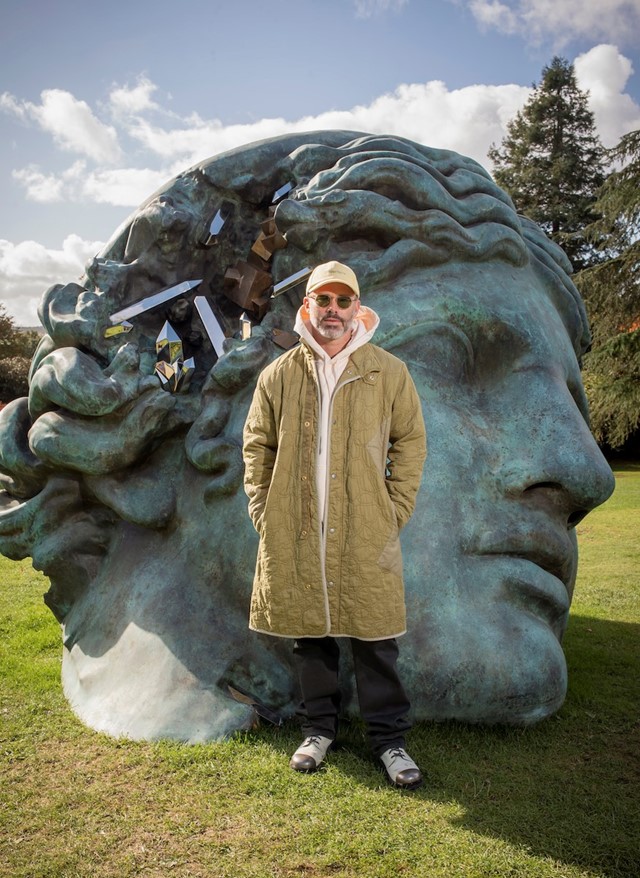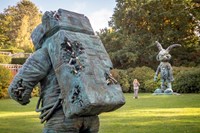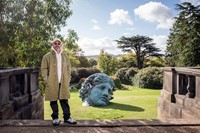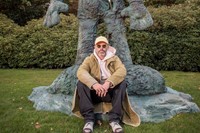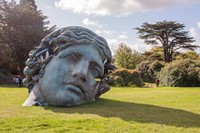The New York-based artist’s new exhibition, Relics in the Landscape, presents six new pieces as part of a “fictional archaeological project” that treat known and recognisable symbols as ancient monuments
“It will be very confusing to archaeologists in thousands of years,” says Daniel Arsham, standing in clean October sunlight in the formal gardens at Yorkshire Sculpture Park. “It’s a blending of time, mixture of materials.”
The New York-based multidisciplinary artist is talking about his new show, Relics in the Landscape – six new pieces that will live at YSP for the next year and which make up not only his first UK museum display but also his first exhibition of exclusively outdoor pieces. The sculptures are, according to Arsham, part of a “fictional archaeological project” and include replicas of classical works from antiquity, depictions of iconic moments in history and of instantly-recognisable pop culture motifs.
There’s classical goddesses but there’s also the bike from ET, Neil Armstrong and Bugs Bunny, all rendered in bronze. They are all alike, all completely different: what appears at first random are revealed to be uniform and deliberate. The works are at once brand new but also historic artefacts, inorganic but enveloped into the greenery of the park. They are documents and relics from both long ago and right now. “It’s about time dislocation and dissociation which is confusing and forces us to think about our own experiences of time,” explains Arsham.
He was given access to foundry moulds from some of the most famous classical sculptures in the Louvre including the head of a female figure known as Melpomene – the Greek muse of tragedy – which was originally carved around 50 BCE. Arsham created Unearthed Bronze Eroded Melpomene (2021) from the same mould but on a different scale, with his own alterations explaining how even what we think of as original pieces rarely are. “[Older sculptures] are not ancient monuments,” he says. “They are doctored and manipulated over time.”
Another classical piece is the Bronze Eroded Venus of Arles (Large) 2022, another retelling from moulds in the Louvre. Arsham describes how in one of the statue’s previous carnations Venus’s head was taken off and rearranged to completely alter the direction of her gaze.
Elsewhere, there’s Bronze Crystallized Seated Pikachu (2022), a character from the cult Japanese animated world of Pokémon and Bronze Eroded Astronaut (2022), a 3D version of a one of the most famous images of all time – Neil Armstrong during the Apollo 11 Moonwalk in 1969. Meanwhile Bronze Extraterrestrial Bicycle (2022) – is a replica of the original bike from ET. Arsham took every single element apart and cast each in bronze. The sculpture now stands in the middle of a waterlily pond, overlooked by the towering Bronze Eroded Bunny (Large) (2022).
His subject matter is almost always iconic or ubiquitous items that are easy for audiences to access. “Whenever I select objects I’m looking for something in some way universally known,” he says. “I think most artists work with symbols. But in the projects I work on it requires [audiences] to know something about the object. In this way, it creates an intimacy.”
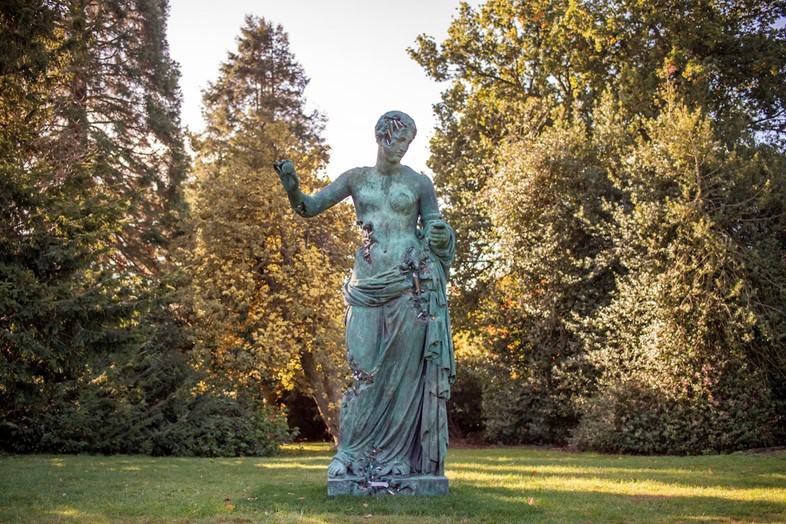
One of the things each piece in Relics in the Landscape has in common with its counterparts is deliberate patches of decay. Venus’s waistline wastes away on her right side, decay has set in all over Neil Armstrong’s space suit. But where the bleak nothingness of corrosion might usually sit, are beautiful angular crystals cast in bronze.
This is nothing if not a clear metaphor for change and regeneration. But when asked if his work is more about decay or growth, Arsham simply responds: “Depends how you look at it.” With such themes so central to Arsham’s work, it’s hard not to consider their seedlings.
In 1992, Hurricane Andrew ripped through swathes of Florida and Ashram’s family home was completely destroyed. He acknowledges that the influence of this extraordinary and devastating event on his work is “a bit obvious” but ultimately the fact remains that he “saw [the house] being disassembled in a storm and then it was built back exactly the same as before.” It would be strange if this hadn’t had any obvious impact on his practice.
Time and again in his work, Arsham explores or collaborates with urban or high fashion people or brands - from Dior to Pharrell Williams to Porsche - but is always in service to organic, natural materials, mechanisms and processes. “Material is very important in the way that I think about communicating an idea,” he says. “The material of the thing can tell you as much about what it’s about.
All of his works at YSP are created using traditional patinated bronze – that jewel-like shade of deep green. This is an aesthetic that speaks to the effect of time and weather on metal, but in Arsham’s case, the classical patination is as a result of forced oxidisation. All of this distorting of time raises questions of authenticity. It makes you ask: what’s real? “There’s a lot of fiction in sculpture and history,” says Arsham, before asking. “Can I project that forward?” But it feels like he already has.
Relics in the Landscape is on display at Yorkshire Sculpture Park until September 30, 2023.
